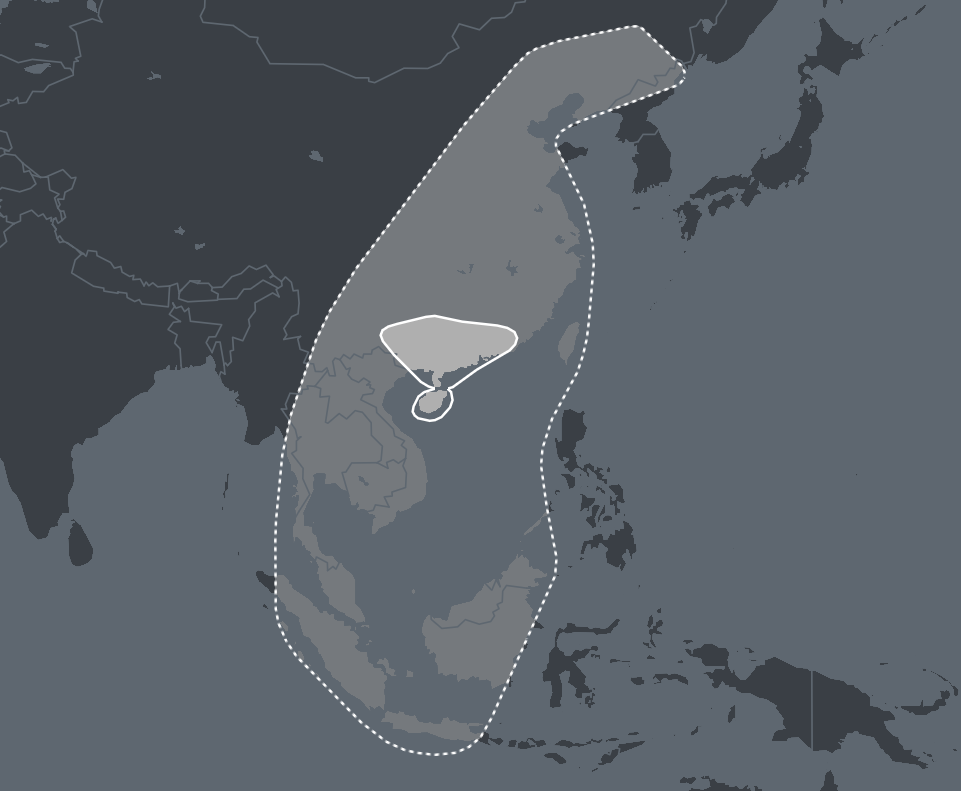What is Southern China DNA Ethnicity on Ancestry?
The results of our AncestryDNA tests may sometimes be what we expect or on occasion may be a big surprise. Either way, often we need a little more information regarding some of the regions that arise in our ethnicity estimates.

One region that is not at all uncommon is the Southern China DNA region. Those who still live in this region already understand all about its history and culture. There are others, however, who may never have even visited or in fact been aware that they have ancestors from that area.
In this post, we will go into more detail with regard to the history, geography, and culture of the Southern China region. We will also discuss what it means to be from this region and how easy or difficult it might be to trace our roots in the Southern China Region.
What Is the Southern China DNA Region?
The Southern China DNA region covers a large area along the east coast of China and down into Southeast Asia. It includes the Chinese provinces of:
- Jilin
- Liaoning
- Hebei
- Shanxi
- Shandong
- Henan
- Hubei
- Jiangsu
- Anhui
- Chongqing
- Zhejiang
- Jiangxhi
- Fujian
- Guizho
- Yunnan
- Guangxi
- Guangdong
- Hainan

This DNA region also extends into other Asian nations both in the north and south extremes of its range. These countries are:
- North Korea
- Taiwan
- Laos
- Myanmar
- Thailand
- Cambodia
- Vietnam
- Malaysia
- Brunei
- Singapore
- Indonesia
Southern China DNA Region Subregions
As part of the Southern China region the Eastern China and Southeast Asia subregion is itself broken down into four other regions. These regions can be beneficial in helping researchers to pinpoint where in this vast region their ancestors may have originated from. These smaller regions are:
- Guangdong, Fujian, Zhejiang & Shanghai
- Guangzhou
- Southeast China & Malaysia
- Southern Central Asia
Southern China Region History
The Southern China region was once home to the Yangshao culture which was prevalent in the area dating back to 5,000 – 2,000 BC. Evidence of human habitation and that of other human relatives such as homo erectus date back hundreds of thousands of years in the region with huge finds of homo erectus skeletons being well known including the famous Peking Man.
Yangshao Culture
The Yangshao was a neolithic culture found mostly along the middle reaches of the Yellow River. They flourished in the region which is today occupied by the Henan, Shaanxi, and Shanxi provinces. They seem to have favored small-scale cultivation over high-yield agriculture and would move to new lands once the local soil quality was depleted.
The Yanghao also kept livestock such as pigs, sheep, goats, and cattle but much of their meat still came from hunting and fishing.
The Beginning of the Dynasties
Chinese tradition suggests that the Dynastic system that would become the ruling class for millennia first emerged around 2,100 BC. The first dynasty was the Xia and for many years historians thought them to be potentially just legendary. Recent archaeological digs in Henan province however seem to support their existence as a real dynasty.

The successors of Xia the Shang dynasty ruled between 1766 – 1122 BC and are the first confirmed dynasty with scholars still undecided if Xia was anything more than a mythical dynastic power. There would be numerous dynasties that would come into power over the millennia with internal power struggles being very common.
Southeast Asia History
Archaeology suggests that the Southeast Asia region was home to Homo erectus around 1,500,000 years ago. More recently however it is thought the first modern-day humans arrived in the area from East Asia somewhere between 70,000 – 50,000 BC. There was also an interesting population of smaller humanoids known as Homo floresiensis who were native to Indonesia 50,000 years ago.
Early humans in the region were hunter-gatherers who exhibited a lineage from Papua (Indonesia and East Asia via the mainland. Later however Austronesians from modern-day Taiwan expanded throughout Southeast Asia. The descendants of these peoples make up the modern-day populations of Brunei, Indonesia, Timor Malaysia, and the nearby Philippines.
Austronesians
The Austronesians were a prolific group among the Islands of Asia and accordingly, they were a seafaring group who spread well beyond the Southeast Asia DNA region. Their expansion in the region began around 2,200 BC.

As the Austronesians spread out they took with them their language and some notable cultural traditions. These include tattooing, stilt houses, jade carving, wetland farming, and rock art.
Indian Influences
Around the 1st century AD contact with the Indian subcontinent through trade started to bring Hinduism and Buddhism to the region. This would begin to replace the native animist beliefs that focused on ancestor, nature, and spirit worship. It was Indian Brahmins and traders who brought with them these new religions.
The rapid spread of these new religions would push those who wished to hold onto their traditional beliefs into more remote Island regions of Southeast Asia. These would include the Maluka Islands as well as New Guinea.
Contact with India ultimately led to various Hindu and Buddhist kingdoms arising in the region over the ensuing centuries.
Spread of Islam
Around the 8th century, Islam started to make inroads into the Southeast Asia region. This happened through the Umayyads, a group that at one time spanned North Africa, Arabia, and East Asia. The trade routes established by them reached all the way to southeast Asia taking with them their religion.
Other Outside Influences
As the centuries progressed influences and migration into the region occurred from many nations outside of Southeast Asia. These included the Chinese, Portuguese, Spanish, Dutch, and the Japanese
How Did You Get Southern China Region DNA?
If you already know that you had family who came from Southern China or any of the bordering Asian states, then you know why you have Southern China region DNA. If this result came as a surprise, you may not know how exactly you came by DNA from this region.

If you have a sizable percentage of DNA from this region, then it is likely you have an ancestor who was born in or close to the country of Southern China.
Is the Result Accurate?
When it comes to ethnicity estimates, the higher the percentage you have from a certain region the more likely it is to be accurate. If your percentage is low, however, then it is harder to pinpoint exactly where your most recent ancestors came from.
A low result could mean a distant ancestor from that region. It is best to focus on your highest-rated region's matches to determine where your ancestors came from more recently. A low percentage can often be hard to locate because the ancestor in question could be many generations back in your tree.
How to Research My Ancestry from These Regions
The results of a DNA ethnicity test are of course a great place to start, especially if there is an unexpected result found in the report. As always of course DNA cannot tell the whole story and we need to actually do the research work.
A percentage on an ethnicity estimate means very little unless you follow through and start building up your family tree. The relevant ancestors may be several generations back and it may take a lot of research to discover who they were.
If you have specific regions mentioned in your report, then you have a good idea of where your ancestor may have originated from. Ancestry DNA even has migratory information from some of these regions through to the final settlement places in the United States or elsewhere in the world.
Using Ancestry, you may be able to determine not only who your ancestors were from the British Isles but perhaps the reason they decided to move.
Southern Asian Migration
The DNA that spans this huge region has come together from many different early peoples and has developed to be distinct. There have been a number of reasons for migration out of the region based on political internal issues, war, and a simple need to find a better life.
Migrants from China, Korea, Vietnam, Cambodia, and other nations in the region have created communities around the world and especially in the United States. The bulk of the migration occurred over the past few centuries in the form or Chinese workers and Southeast Asian refugees looking to flee political unrest and the consequences of wars in certain countries
Final Thoughts
A combination of early Chinese cultures, Austronesians, peoples from East Asia, and to a smaller extent Papua the peoples of this region are hugely diverse in their beliefs and culture but share common genetic traits that help define the region.
Smaller subregions that may appear alongside this region in an ethnicity estimate may help you discover where your most recent ancestors may have come from.
Link To or Reference This Page
We spent a lot of time downloading, cleaning, merging, and formatting the data that is shown on the site.
If you found the data or information on this page useful in your research, please use the tool below to properly cite or reference Name Census as the source. We appreciate your support!
-
<a href="https://namecensus.com/blog/what-is-southern-china-dna-ethnicity-on-ancestry/">What is Southern China DNA Ethnicity on Ancestry?</a>
-
"What is Southern China DNA Ethnicity on Ancestry?". NameCensus.com. Accessed on May 4, 2024. https://namecensus.com/blog/what-is-southern-china-dna-ethnicity-on-ancestry/.
-
"What is Southern China DNA Ethnicity on Ancestry?". NameCensus.com, https://namecensus.com/blog/what-is-southern-china-dna-ethnicity-on-ancestry/. Accessed 4 May, 2024
-
What is Southern China DNA Ethnicity on Ancestry?. NameCensus.com. Retrieved from https://namecensus.com/blog/what-is-southern-china-dna-ethnicity-on-ancestry/.
